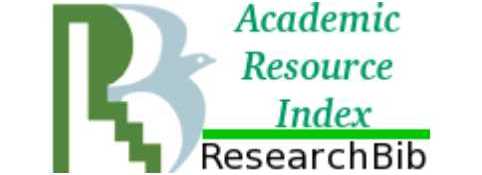THE PHILOSOPHICAL AND METHODOLOGICAL FOUNDATIONS OF COMPREHENSIVE ASSESSMENT AND MANAGEMENT OF THE ENVIRONMENTAL QUALITY
Abstract
The environmental quality is a multilateral performance standard socio-natural relations whose functional significance lies in the ability to reflect the optimal processes of environmental safety. The philosophical and methodological interpretation of the problem has a character of giving solutions to the dialectical contradiction between the state of a natural element in the biosphere and the form that enables it to satisfy the needs of society. This approach can develop the methodological basis for a comprehensive assessment of the state of natural components, effective when the environment acts as a limited source of economic resources, and the problem of social and natural optimization cannot be reduced to optimizing the quality of natural objects only by improving their economic performance.Keywords: environmental quality, comprehensive assessment, quality and quantity of conjugated indicators of sustainable development, rents
1. Introduction
The problem of assessing the quality of the environment is a society-nature relationship optimization problem. It is not confined to the conservation and protection of nature from all forms of human impact. The quality of the environment cannot be kept static. It is a product of socio-natural interactions and a normal byproduct of human activity. People can only live in socially adapted conditions. Economic evaluation of environmental quality requires a set of economic, biological, medical, biological, aesthetic criteria. This approach poses the problem of conceptual integration of quantitative indicators of sustainability from the perspective of ecological and economic evaluation.
2. Research findings
The theoretical basis for the development of appropriate approaches to assess the quality of the environment, the formation of complex valuation principles allowing the assessment of the environmental quality in order to eliminate the internal contradictions between quantitative and qualitative indicators, is the philosophical methodology. The philosophical methodological development is the starting point for the valuation on environmental quality methodologies and allows one to create a comprehensive environmental function based assessment: environmental, economic, bio-geocenosis, medical-biological, aesthetical etc.
The ecological and economic unit is the most specific in the structure of a comprehensive assessment, as in the economic interpretation of the environmental issues dominating is the utilitarian approach of the assessment procedure. Since the first theoretical approaches on environmental economics of the human environment have been interpreted in strictly economic terms, and since that time the functional contradiction between quantitative and qualitative approaches to the study of the natural environment forced researchers to seek ways and means to shape comprehensive quantitative and qualitative interpretation.
In today's economy, such approaches are mainly developing mechanisms to assess significant characteristics of the material, expressed in certain cash equivalents, and in this respect the economic assessment of the environment has been developed on the areas of the environment, which is a source of raw materials.
Valuation approach from the perspective of identifying economically utilitarian benefits is based on the identification of quantitative characteristics and interpreted in their overwhelming majority, in numerical, that is, in terms of money. Trying to interpret the environmental assessment in neutral terms - points just does not solve the problem because the situation does not outweigh the highly specialized utilitarian approach.
In should be noted that the conclusion on the theoretical possibility of technical endowment opportunities for natural systems is not agreed by all researchers. In this question, in our opinion, not enough sound is the complex technical ability to integrate in a biocenosis as a structural systemic element. In this respect, of interest are the arguments about the relationship between technique and nature, based on the machinery use in the garden. Machinery is needed in the garden, as without it the garden couldn’t be neat and tidy. At the same time, machinery does not harmonize with the garden nor functionally, nor structurally because it is the opposite to life and disturbs the natural harmony of the garden.
Apparently, there is no use to dwell on the problem of "naturalness" of the garden, in which creation an indispensable part took the "machine" as a set of technical means of anthropogenic impact on environment. The criteria analysis by which the classification is made in internal "limited" systems and external "unlimited" elements is mistakenly done on the principle of the inexistence of human interdependence. The estimated differential is carried out on two grounds: first, on the belonging to the living, and, second, on the functionally lack of harmony of the machinery in relation with the culture biocenosis.
The lack of consistency of the first argument becomes obvious if we remember that the structure of the environment system is not only formed from living matter, but also from a-biotic elements – soil, water, and other specific landscape and other non-living components, as well as machinery, without which however, the living substance in the garden cannot exist. Therefore, considering these circumstances the criteria evaluation loses its rigor and acquires a certain subjective aspect.
With this approach, it becomes possible to arbitrarily manipulate the evaluation criteria based on the personal views of the positive and negative anthropogenic environmental impact.
This is also a subjective criterion of inorganic functionality of the ecosystem because it contains no answer to the question: "Can the garden maintain its systemic soundness in a non functional relation with the machine solely by implementing its own regulatory potential?" Such a response can only be negative. Any culture ecologic system cannot exist due to its internal reserves, regardless of technical endowment of the society. Permanent purposeful anthropogenic interference (cultivation, harvesting, irrigation etc.) determines the normal development of each agricultural biocenosis. Because such an impact can carried out only by the "machine", that is with the help of technical tools, we obtain a functional integrity "machine-garden". The technical complex (irrigation system, land cultivation etc.) is a necessary, internal component of any culture ecological system. Machine as a set of technical means is an organic garden. Its possibility to disturb the harmony of the garden is not excluded to the same extent that it is not excluded the probability of such violations from natural factors. Therefore a comprehensive economic and ecological evaluation based on the optimum relationship between living matter and complex artificial technical objects is needed.
Environment can and should be "optimized" by anthropogenic transformation. The assessment issue is solved by sufficient scientific basis of the assessment process, sound information on interaction parameters of the socio-natural relationships optimality and strict adherence to the evaluation criteria. In accordance with the received methodological scheme is necessary to define the baseline assessment, use traditional or create new assessment tools to develop a search algorithm, coordinate and control separate evaluation operations.
Theoretical description of the objects should be present in solving empirical and constructive tasks, when a classification of ecological linkages is needed. The result of this development is the formation of complex representation of the level and assessment criteria of socio-natural interaction.
In culture biocenosis there is no closure of systemic cycle of production of biomass, because the process is artificially interrupted and the bio-organic mass is extracted from the production cycle at an early stage. The functioning of culture ecosystems is built on a conscious violation of the law of return items and the threshold of the produced biomass depends on the non-returned to the soil elements used by organisms. It should be noted that as a result of the yearly harvesting, soil significantly reduces its vital content. Removing elements from the soil significantly undermines its fertility and finally depletes ecosystems if in the same time no biotechnological activities are carried out, including the return to the soil of lost mineral and organic elements.
In modern technical processes it is difficult to avoid disturbing the natural ecological processes. The selfregulation possibilities of the entire biosphere and its individual subsystems are far from unlimited. At the same time, society as an interdependence element is practically unlimited in its technological genesis capacity. Therefore, in the interaction society-nature appears as possible the stage when the biosphere, significantly undermining its self management resources under the pressure of human impact, will be unable to maintain its structural and functional organization and the function of maintaining the dynamic balance of nature will have to be performed by humankind.
The ability to control the dynamics of biosphere processes and make periodic adjustments to the consequences of technological development of the natural sphere can be accomplished only at a high level of scientific and technical equipment of society and its social systems. Therefore, the yield of the complex confrontation between man and nature can be found in optimized regulatory anthropogenic activities on the environment.
Built environment cannot be external, fundamentally different with respect to the biosphere. Bio-geocenosis in addition to social functions must preserve its functional defined division in a system of natural links. At the level of artificial ecological support systems of living matter requires an optimal combination of biological organisms ’ activities and technological activities of human society. In this case, the task is to conceptually combine the knowledge about natural environment and the role of man-made objects in a single eco-economic system.
The problem of replacing natural systems with self regulation mechanisms with anthropogenic ones is linked to the analysis of management capabilities and transformation processes of matter and energy, not only between living organisms and their environment, but also between man-made and natural systems. This task updates the formation of environment management strategies.
The problem of the environmental quality acquires the character of a solution to the contradiction between the state one biosphere natural element and the measure of its capability to meet the needs of an individual. Therefore rents become economic measures for the state of nature components, so the term is focused on the applied nature of socio-natural relations, when the natural environment is an endless source of economic resources. The social and natural optimization problem can be reduced to a series of specific problems to improve the quality of natural systems by improving the economic characteristics: soil fertility, species composition of the forest ecological community, reclamation of waterlogged and therefore economically non-productive land, etc.
There is a basic contradiction in the economic interpretation of the problem of environmental quality and without overcoming flawed assumptions it impossible to obtain a methodologically competent enough conjugation of quantitative and qualitative indicators and an integrated environmental-economic evaluation.
Utilitarian orientation estimates do not take into account the value of the environment itself. This approach is limited, as anthropocentrism does not imply the conservation of the natural environment as a self-sufficient and self- reliant system.
The raw approach, accompanied by the destruction of natural resources, excludes from the economic interpretation area the whole block of environmentally appropriate areas of social nature. Significant reserves of economic benefits from the social use of the environment have the so-called environmental services associated with the natural goods. Ecological and economic approach to the assessment of sustainable development in the functional sense is an economic assessment of the environmental impacts of either environmental benefits, or environmental losses resulting from socio-natural interactions at the level of human pressure.
This approach can be applied to develop assessment methodologies for the natural resources potential of an area, meaning an essentially comprehensive evaluation of the economic potential of the area, associated with the exploitation of its ecological status.
The need to develop market mechanisms in the field of environmental quality is based on a growing concern regarding the anthropologic impact on natural environment. Allocation of pollution certificates as well as their trade on the international market is not directly linked with the concept of the environment as a source of raw material resources, and it is based on the recognition of the uniqueness of historical natural biogeocenosis. As an economic tool in ensuring the optimization processes of nature, it can serve as payment for the environmental management. Schematically, the introduction of charges for natural resources is a means of economic regulation of the dynamics of nature. It is developed with the aim of achieving the highest valuation adequacy of the environmental impact of various forms of social consumption of natural environment. The greatest financial burden payment for natural resources should be in the area of human activity and resource intensive activities economically interpreted in the form of differential rent. As it is known, rents are treated in the economy as "God-given blessing" and are a specific form of obtaining material benefits associated with the circumstance of land ownership. Since abstract land does not exist on every piece of land something is growing, and what is growing fills that piece of land, the land can be evaluated on the basis of its natural conditions or artificial ones. Introduction of the differential rent is very specific and interesting aspect. By itself, the economic rent as the right to use land is quite abstract. In the event that a piece of land belongs to the property of a business entity should be considered a form of practical operation of this site. So, if the plot of land on which the natural, untouched, ecological system is not subjected to anthropogenic transformation, then this site cannot be considered as a source of raw materials. Without converting its land, the owner receives additional financial benefits from exploiting its ecological importance (relict species, unique character that can be represented by rare species of fauna, etc).
In this case, it appears a specific form of assessment that includes both ecological and economic indicators of sustainable development. If the land owner is the state, the withdrawal of the origin rental income may be gathered in the form of an environmental tax. The bottom line envisages the payment for the use of "weightless utilities", intangible and non-physical expression of environmental values for environmental locations situated anywhere.
Within an evaluation plan, this approach raises the problem of the conceptual integration of sustainability quantitative indicators from the perspective of environmental and economic assessment. Preservation of environmental services excludes industrial use of natural resources as raw materials. Therefore, the development of such mechanism could create the preconditions to create complex economic assessment methods of payment as environmental charges for the provision of environmental services.
The optimization of natural environment usage, taking into account its comprehensiveness and a transition from a one-way feed use to an integrated one, can bring significant economic and environmental benefits. The social use rationalization, with the optimization of the human impact on the natural environment, has significant reserves for improving welfare and sustainable development.
Conclusions
The above results of the study can serve as a conceptual basis for further scientific developments of various aspects regarding sustainable development through the application of innovative technologies and their widespread practical use.


















Reference lists